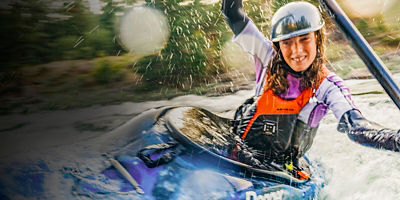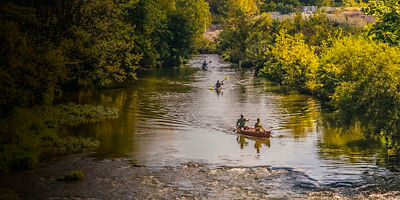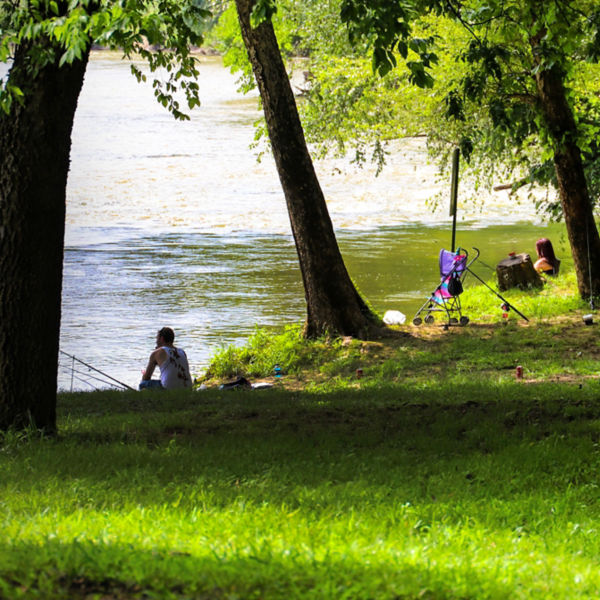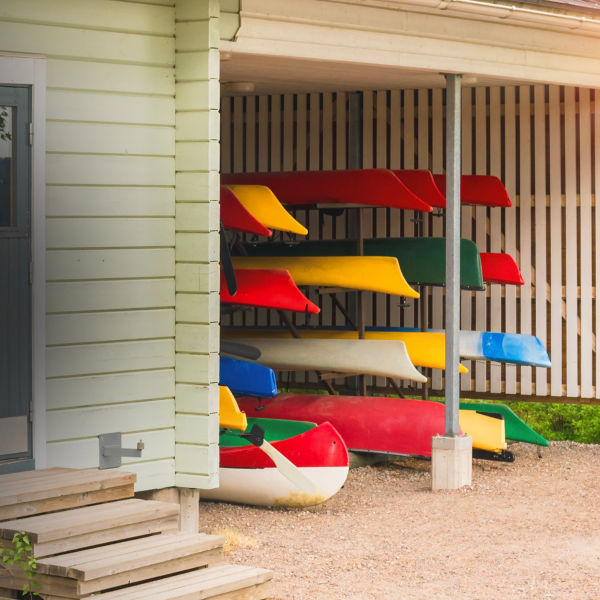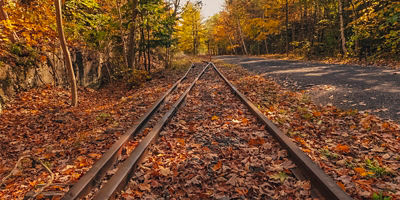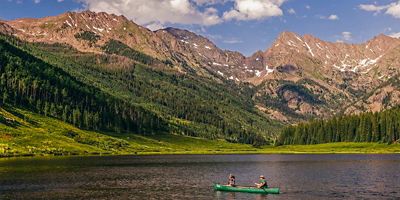PUBLIC LANDS: How did the trip itself go?
ELIZABETH TOBEY: It’s funny; summarizing such a long, involved trip has been one of the biggest challenges of the entire project. It was incredible on a lot of levels. To see the entire length of a river—the landscapes and communities it ties together—puts a lot of things into perspective. Meeting so many people who cared deeply about salmon was incredibly eye-opening. And we’ll never forget the feeling of paddling out into the Pacific after months on the river.
What was the hardest part?
There were obviously physical challenges, but also some mental ones that were more difficult to foresee. The portages were undoubtedly one of the biggest physical hurdles. Portaging around Slide Rapid on the Lower Salmon, hauling all our boats and gear over a massive landslide, made for a hell of an afternoon. We also portaged five of the eight dams on our route, walking our boats anywhere from 2 to 5 miles around each one.
The psychological challenges came more from paddling fatigue—especially toward the end. We were all sleep-deprived and barely able to look at the food we’d been eating for two months. There were days when each one of us was ready to throw in the towel, but fortunately someone always had enough energy to put on a dance playlist and rally the crew’s morale. As far as close calls, one afternoon on the Lower Columbia stands out: We got caught in 8- to 10-foot wind swells, almost got run over by an 800-foot vehicle carrier, and nearly lost one of our sea kayaks all in the span of about an hour.
Did you accomplish your advocacy mission?
While there’s always more that can be done, considering our original goal of raising awareness and getting people involved in the political process of dam breaching, I’d say we accomplished what we set out to do. We connected with hundreds of people at events along our route, from our friends in the whitewater community to tribal representatives, river protectors, and local salmon fishermen. We worked with those people to write hundreds of postcards to Congress. And we connected with people from across the country and even internationally through social media.
Could you see firsthand how the dams have affected the salmon population
Absolutely. Seeing the Lower Snake dams firsthand, along with the conditions they create, was one of the most striking and sobering parts of the expedition. We slogged through the long, hot reservoirs that restrict fish migration and often exceed survivable temperatures. We watched the juvenile fish-transport barges moving downriver and saw the networks of tubes that sort and funnel young salmon into them. We watched a cormorant get shot below the dams by the ‘predatory bird deterrent’ guy. It was hard to take in and made it perfectly clear—in the way only seeing something with your own eyes can—why the dams need to come out, and soon.
Why is preserving them so important?
Thinking about salmon first and foremost as a keystone species tells you everything about why they’re so important. Essentially, removing salmon from an ecosystem has a disproportionately large impact—on the other plants and animals in that ecosystem, but also on human communities. Salmon are literally the foundations of their ocean and mountain homes, and everything in between.
Did the trip also give you a better understanding of the Indigenous populations who have been affected?
This was one of our big goals for this project: to better understand how Indigenous people have been affected by the decline of salmon populations, as well as trying to amplify tribal voices in the fight to remove the LSRDs. Although we as non-Indigenous individuals can’t truly understand how the loss of salmon affects salmon people, talking to tribal elders and representatives helped us see the issue from their point of view. Restoring salmon populations to the Snake and Salmon River systems is a critical component of upholding Tribal Treaty obligations held by the U.S. government. It’s a question of sovereignty and justice, and it’s long past time for action to help bring the salmon back.
What can people do to help?
At the risk of sounding like a broken record, write to your Congresspeople. Encourage them to support the final report that Patty Murray and Jay Inslee recently released and follow their leadership in calling for the breaching of the LSRDs to protect the region’s native salmon populations.
Tell us about the Stibnite Gold Project…did you see firsthand how bad it is for the environment and what can people do to help?
Several team members had a chance to tour the Perpetua mine site with representatives of the company and got a firsthand look into the threats the mine poses to the watershed and its salmon populations. Active drainage from old tailing piles into the upper [East Fork of the South Fork Salmon] is still visible. Although the area is a designated Superfund site and currently in remediation, re-opening of the mine [as proposed by Perpetua] poses massive additional threats to the watershed—and everything downstream. Currently, a key action is pressing the U.S. Forest Service to extend the public comment period on the forthcoming Supplemental [Draft Environmental Impact Statement], which gives people ample opportunity to make their voices heard—visit Idaho Rivers United to make yours heard on this issue.
How can people become environmental advocates even if they don’t have it in them to do such a big trip?
One of the biggest lessons we learned from this project is that you don’t have to be a perfect advocate to do something meaningful. You don’t have to know every detail about the cause you’re supporting. You don’t have to have a graduate degree, and you certainly don’t have to take on a massive campaign by yourself. Our team had the privileges of time and resources, but advocacy can be much simpler than the Grand Salmon. Join a local river cleanup. Write your Congresspeople. Learn as much as you can when you can. Talk to other people and help them understand the issue. Advocacy at its best is the sum of our collective efforts, big and small. You just have to care enough to show up and speak up.
What are your plans for the film and where can people see it?
They’re still in progress. We’re still working out the technicalities of production, but we will be sharing updates via social media and the website as we get further along. We do anticipate submitting to several film festivals such as the National Paddling Film Fest and Wild and Scenic Film Fest, so keep your eyes on those.

























































